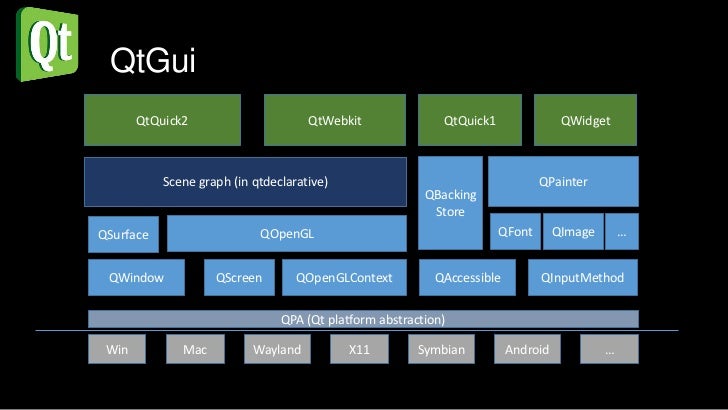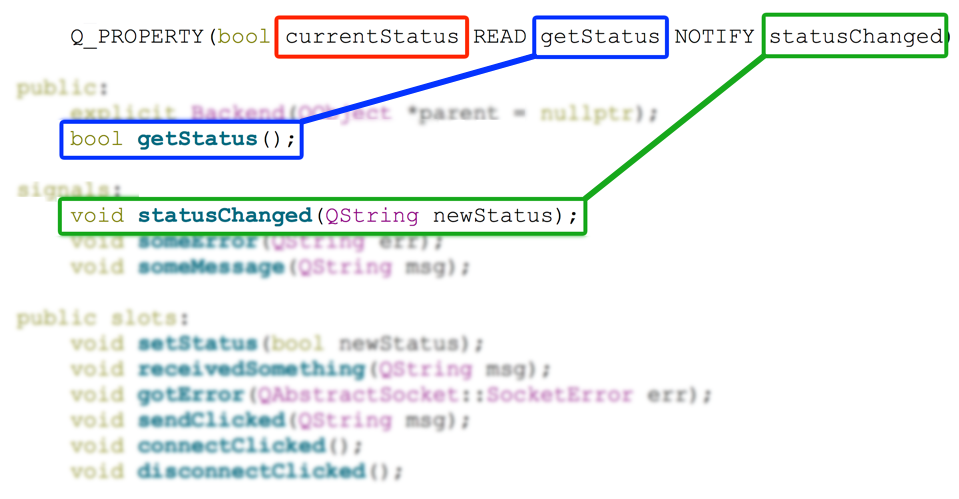Traditional syntax: SIGNAL and SLOT QtCore.SIGNAL and QtCore.SLOT macros allow Python to interface with Qt signal and slot delivery mechanisms. This is the old way of using signals and slots. The example below uses the well known clicked signal from a QPushButton. QML Signal and Handler Event System QML utilizes Qt's meta-object and signals systems. Signals and slots created using Qt in C are inheritely valid in QML. Qt Qml Signals And Slots claim a further 100 free spins plus a 100% match bonus worth up to €/$100! Get 20 Free Spins with No Deposit! New customers only. No deposit winnings capped at €/$20. 50x wagering requirement Qt Qml Signals And Slots applies to FS no deposit. Min €/$20 deposit required to claim each deposit bonus as part of the.
All QML object types are QObject-derived types, whether they are internally implemented by the engine or defined by third-party sources. This means the QML engine can use the Qt Meta Object System to dynamically instantiate any QML object type and inspect the created objects.
This is useful for creating QML objects from C++ code, whether to display a QML object that can be visually rendered, or to integrate non-visual QML object data into a C++ application. Once a QML object is created, it can be inspected from C++ in order to read and write to properties, invoke methods and receive signal notifications.
Loading QML Objects from C++
A QML document can be loaded with QQmlComponent or QQuickView. QQmlComponent loads a QML document as a C++ object that can then be modified from C++ code. QQuickView also does this, but as QQuickView is a QWindow-derived class, the loaded object will also be rendered into a visual display; QQuickView is generally used to integrate a displayable QML object into an application's user interface.
For example, suppose there is a MyItem.qml file that looks like this:
This QML document can be loaded with QQmlComponent or QQuickView with the following C++ code. Using a QQmlComponent requires calling QQmlComponent::create() to create a new instance of the component, while a QQuickView automatically creates an instance of the component, which is accessible via QQuickView::rootObject():
This object is the instance of the MyItem.qml component that has been created. You can now modify the item's properties using QObject::setProperty() or QQmlProperty:
Alternatively, you can cast the object to its actual type and call methods with compile-time safety. In this case the base object of MyItem.qml is an Item, which is defined by the QQuickItem class:
You can also connect to any signals or call methods defined in the component using QMetaObject::invokeMethod() and QObject::connect(). See Invoking QML Methods and Connecting to QML Signals below for further details.
Accessing Loaded QML Objects by Object Name
QML components are essentially object trees with children that have siblings and their own children. Child objects of QML components can be located using the QObject::objectName property with QObject::findChild(). For example, if the root item in MyItem.qml had a child Rectangle item:
The child could be located like this:
Note that an object may have multiple children with the same objectName. For example, ListView creates multiple instances of its delegate, so if its delegate is declared with a particular objectName, the ListView will have multiple children with the same objectName. In this case, QObject::findChildren() can be used to find all children with a matching objectName.

Warning: While it is possible to use C++ to access and manipulate QML objects deep into the object tree, we recommend that you do not take this approach outside of application testing and prototyping. One strength of QML and C++ integration is the ability to implement the QML user interface separately from the C++ logic and dataset backend, and this strategy breaks if the C++ side reaches deep into the QML components to manipulate them directly. This would make it difficult to, for example, swap a QML view component for another view, if the new component was missing a required objectName. It is better for the C++ implementation to know as little as possible about the QML user interface implementation and the composition of the QML object tree.
Accessing Members of a QML Object Type from C++
Properties
Any properties declared in a QML object are automatically accessible from C++. Given a QML item like this:
Qt Qml Signal Slot Example
The value of the someNumber property can be set and read using QQmlProperty, or QObject::setProperty() and QObject::property():
You should always use QObject::setProperty(), QQmlProperty or QMetaProperty::write() to change a QML property value, to ensure the QML engine is made aware of the property change. For example, say you have a custom type PushButton with a buttonText property that internally reflects the value of a m_buttonText member variable. Modifying the member variable directly like this is not a good idea:
Since the value is changed directly, this bypasses Qt's meta-object system and the QML engine is not made aware of the property change. This means property bindings to buttonText would not be updated, and any onButtonTextChanged handlers would not be called.
Invoking QML Methods

All QML methods are exposed to the meta-object system and can be called from C++ using QMetaObject::invokeMethod(). Method parameters and return values passed from QML are always translated into QVariant values in C++.
Here is a C++ application that calls a QML method using QMetaObject::invokeMethod():
| QML |
| C++ |
Notice the Q_RETURN_ARG() and Q_ARG() arguments for QMetaObject::invokeMethod() must be specified as QVariant types, as this is the generic data type used for QML method parameters and return values.
Connecting to QML Signals
All QML signals are automatically available to C++, and can be connected to using QObject::connect() like any ordinary Qt C++ signal. In return, any C++ signal can be received by a QML object using signal handlers.
Here is a QML component with a signal named qmlSignal that is emitted with a string-type parameter. This signal is connected to a C++ object's slot using QObject::connect(), so that the cppSlot() method is called whenever the qmlSignal is emitted:
When a QML object type is used as a signal parameter, the parameter should use var as the type, and the value should be received in C++ using the QVariant type:

Earlier this week, I posted an example of integrating QML2 and C++. In it I showed how to call a C++ method from QML, but finished my post with this statement.

Warning: While it is possible to use C++ to access and manipulate QML objects deep into the object tree, we recommend that you do not take this approach outside of application testing and prototyping. One strength of QML and C++ integration is the ability to implement the QML user interface separately from the C++ logic and dataset backend, and this strategy breaks if the C++ side reaches deep into the QML components to manipulate them directly. This would make it difficult to, for example, swap a QML view component for another view, if the new component was missing a required objectName. It is better for the C++ implementation to know as little as possible about the QML user interface implementation and the composition of the QML object tree.
Accessing Members of a QML Object Type from C++
Properties
Any properties declared in a QML object are automatically accessible from C++. Given a QML item like this:
Qt Qml Signal Slot Example
The value of the someNumber property can be set and read using QQmlProperty, or QObject::setProperty() and QObject::property():
You should always use QObject::setProperty(), QQmlProperty or QMetaProperty::write() to change a QML property value, to ensure the QML engine is made aware of the property change. For example, say you have a custom type PushButton with a buttonText property that internally reflects the value of a m_buttonText member variable. Modifying the member variable directly like this is not a good idea:
Since the value is changed directly, this bypasses Qt's meta-object system and the QML engine is not made aware of the property change. This means property bindings to buttonText would not be updated, and any onButtonTextChanged handlers would not be called.
Invoking QML Methods
All QML methods are exposed to the meta-object system and can be called from C++ using QMetaObject::invokeMethod(). Method parameters and return values passed from QML are always translated into QVariant values in C++.
Here is a C++ application that calls a QML method using QMetaObject::invokeMethod():
| QML |
| C++ |
Notice the Q_RETURN_ARG() and Q_ARG() arguments for QMetaObject::invokeMethod() must be specified as QVariant types, as this is the generic data type used for QML method parameters and return values.
Connecting to QML Signals
All QML signals are automatically available to C++, and can be connected to using QObject::connect() like any ordinary Qt C++ signal. In return, any C++ signal can be received by a QML object using signal handlers.
Here is a QML component with a signal named qmlSignal that is emitted with a string-type parameter. This signal is connected to a C++ object's slot using QObject::connect(), so that the cppSlot() method is called whenever the qmlSignal is emitted:
When a QML object type is used as a signal parameter, the parameter should use var as the type, and the value should be received in C++ using the QVariant type:
Earlier this week, I posted an example of integrating QML2 and C++. In it I showed how to call a C++ method from QML, but finished my post with this statement.
Qt Signal Slot C++ Qml
I'm still new to Qt, so this may not be the best way. It looks like you can also use signals, which would probably be better as it means your QML application isn't tied to your C++ implementation, but I haven't yet got that working.
I have now found a way to use signals and slots to do this, which I will describe here.
Signals and Slots
Signals and Slots are a feature of Qt used for communication between objects. When something happens to an object, it can emit a signal. Zero or more objects can listen for this signal using a slot, and act on it. The signal doesn't know if anything is listening to it, and the slot doesn't know what object called it.
Epiphone casino p90 covers. This allows you to design and build a loosely coupled application, giving you the flexibility to change, add or remove features of one component without updating all its dependencies, so long as you continue to emit the same signals and listen on the same slots.
You can see why this might be useful in GUI programming. When a user enters some input, you may want to do a number of things with it. Maybe you want to update the GUI with a progress bar, then kick off a function to handle this input. This function might emit a signal letting others know its progress, which the progress bar could listen to and update the GUI. And so on.
Even outside of GUI programming this could be useful. You might have an object watching the filesystem for changes. When a change happens, you could emit a signal to let other objects know about this change. One object might run a process against this file, while another object updates a cache of the filesystem.
The example application
I'm going to create the same example application as I did before. It will contain a text field and a button. You enter some text in the text field, and once you click the button the text will be converted to upper-case. The conversion to upper-case will be done in C++, and the interface drawn in QML2.
The source of the finished application is available on GitHub.
Emitting a signal from QML and listening to it from C++
To create a signal in QML, simply add the following line to the object which will emit the signal.
Here I have created a signal, submitTextField, which will pass a string as an argument to any connecting slots (if they choose to receive it).
I'm going to add this signal to the Window. I will emit the signal when the button is pressed, passing the value of the text field. Here is the full QML document.
We can run that and click the button. The signal is being emitted, but because no slots are listening to it nothing happens.
Let's create a C++ class to listen to this signal. I'm going to call it HandleTextField, and it will have a slot called handleSubmitTextField. The header file looks like this.
The class file has a simple implementation for handleSubmitTextField.
To connect the QML signal to the C++ slot, we use QObject::connect. Add the following to main.cpp.
We need an instance of HandleTextField, and the QML Window object. Then we can connect the windows submitTextField signal to the handleSubmitTextField slot. Running the application now and you should get a debug message showing the text being passed to C++.
Emitting a signal from C++ and listening to it from QML
Now we want to convert the string to upper-case and display it in the text field. Lets create a signal in our C++ class by adding the following to the header file.
Then change the handleSubmitTextField function to emit this signal with the upper-cased text.
Notice we are passing the text as a QVariant. This is important, for the reasons well described in this Stack Overflow answer.
The reason for the QVariant is the Script based approach of QML. The QVariant basically contains your data and a desription of the data type, so that the QML knows how to handle it properly. That's why you have to specify the parameter in QML with String, int etc. But the original data exchange with C++ remains a QVariant
We now need a slot in QML to connect this signal to. It will handle the updating of the text field, and is simply a function on the Window.
Qt Qml C++ Signal Slot
Finally we use QObject::connect to make the connection.
Run the application, and you should now see your text be converted to upper-case.
Next steps
It feels like more work to use signals and slots, instead of method calls. But you should be able to see the benefits of a loosely coupled application, especially for larger applications.
I'm not sure a handler class for the text field is the best approach for this in practice. In a real application I think you would emit user actions in your GUI and have classes to implement your application logic without knowledge of where that data is coming from. As I gain more experience with Qt, I will update the example with the best practice.
Check out the full application on GitHub.
Cover image by Beverley Goodwin.